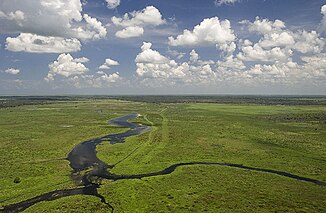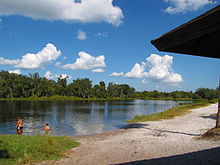Fisheating Creek
| Fisheating Creek | ||
|
Aerial view of the water |
||
| Data | ||
| location | Florida , United States | |
| source | west of Lake Placid , Florida 27 ° 19 ′ 58 ″ N , 81 ° 32 ′ 19 ″ W |
|
| muzzle | in the Fisheating Bay of Lake Okeechobee Coordinates: 26 ° 58 ′ 15 ″ N , 81 ° 6 ′ 2 ″ W, 26 ° 58 ′ 15 ″ N , 81 ° 6 ′ 2 ″ W.
|
|
| length | 64 km to 82 km | |
Fisheating Creek is a river in Florida that flows into Lake Okeechobee . It is the only remaining free-flowing watercourse that flows into the lake and the second largest spring that feeds the lake. Most of the land by the river is publicly owned or the development is restricted by environmental regulations. The lower reaches of the river are largely in their original state, but efforts are being made to restore the upper reaches to a more natural state.
description
The name Fisheating Creek is derived from the seminolic name for the river, Thlothlopopka-Hatchee , which can be translated as "the river where fish are eaten". The length of Fisheating Creek is stated differently; it ranges from 64 km to 82 km. The body of water flows south through an area in southwest Highlands County called Cypress Swamp and into Glades County , where the body of water turns east about two kilometers north of Glades County Road 731 and flows 20 miles to Lake Okeechobee. The river is spread over the last eight kilometers of its course in the Cowbone Marsh, a marshland before it flows into the lake. Fisheating Creek is the second largest natural freshwater source for Lake Okeechobee and contributes nine percent of the amount of water that flows into the lake.
The headwaters of Fisheating Creek form a series of persistent marshes in Highlands County west of Lake Placid . Each of these marshes slowly overflows and gives off water to the next lower marsh until the Fisheating Creek is finally created. In the 20th century, ditches and a canal crisscrossed these marshes and drained the area to turn it into agricultural land. In 2010, the United States Department of Agriculture acquired a conservation easement over 26,000 acres of land in Highlands County south of State Road 70 and plans to convert the land in this area back into marshland. This measure means that the property will remain with the previous owner, but the US government will have the permanent right to dispose of the land for conservation purposes. The binding effect corresponds roughly to an easement under German law.
Fisheating Creek flows through a prairie landscape , both dry and damp, which is characterized by freshwater swamps , so-called hammocks - these are slight elevations made of limestone that are densely overgrown by trees, alluvial forests and floodplain swamps. Human interference has brought other land uses to the area, including eucalyptus and pine plantings . In 1842, in the dry season, Fisheating Creek was described as a large flowing body of water, very "winding", the width of which varies from a stream to a river. Lake Okeechobee was artificially kept at a lower level than it was before the 20th century, and so much of the Cowbone Marsh was drained and converted to agricultural land. The lake is almost completely enclosed by the Herbert Hoover Dike . The only gap in the levee is at Fisheating Creek, where the levee follows the two banks of the river for a distance of several kilometers, so the creek is the only uncontrolled tributary of the lake.
The watercourse is almost entirely within the Fisheating Creek Wildlife Management Area. The only settlements near Fisheating Creek are Palmdale near where US Highway 27 crosses the watercourse and Lakeport where the creek meets Lake Okeechobee. Twenty-seven rare species inhabit the Fisheating Creek catchment area. The preservation of the ecosystem of the Fish Eating Creek is considered crucial for the long-term survival of Florida panther , American Black Bear , swallow-tailed kite , whooping crane , sandhill crane , Schopfkarakaras and other species in the region.
history
The area around Fisheating Creek was inhabited by members of the Belle Glade culture as early as 1000 BC. In the area there are several archaeological sites in the area, the most famous of which is known as Fort Center . It was inhabited from around 450 BC to around 1700.
Fort Center is a palisade of palmetto palm trunks named after Lieutenant JP Center of the United States Army and built during the Second Seminole War . This fort gave the archaeological site its name. 1842 explored a force of 83 sailors and marines of the United States Navy under the leadership of John Rodgers in 16 carved wooden canoes Key Biscayne from the Everglades , Lake Okeechobee and both the Kissimmee River up to Lake Tohopekaliga and the Fish Eating Creek to End of its open waterway before returning to Key Biscayne. Fort Center was already deserted by then, and the expedition members had to repair the palisade while they stayed there for a few days. The fact-finding mission found evidence that the Seminoles lived in the Fisheating Creek area, but did not encounter any of them during the 60 day exploration. Fort Center was during the third Seminole reactivated and served as a station at the Military Road from Fort Myers by Fort Jupiter , wherein a part of the route provided for the use of canoes over Lake Okeechobee time.
An investigation in 1881 found that the area around Fisheating Creek was one of five areas in Florida inhabited by Seminoles. The non-Indian settlement of the area began in the 20th century; Lakeport at the mouth of Fisheating Creek was established in 1915. The increase in development around Fisheating Creek drove the remaining Seminoles almost completely out of the area by 1930, even if the Brighton Seminole Indian Reservation, founded in 1935, is in the vicinity of the water in Glades County.
Current Status
Lykes Brothers acquired the land around Fisheating Creek at the beginning of the 20th century and used it as largely undeveloped pasture. The company owned 67% of the land in Glades County. For many years, the Lykes Brothers gave the public access to the body of water and adjacent land, including a waterfront park, campground, and canoe rental in Palmdale and 76,000 acres of land leased to the general public for hunting in Florida has been.
Lykes Brothers began restricting public access to their land on Fisheating Creek in the 1980s, apparently in response to the rise in vandalism and poaching . In 1987, the Lykes Brothers no longer renewed the contract for the Wildlife Management Area, but leased the land to a private company that levied fees for hunting rights on the land. In 1989, Lykes Brothers also closed the swimming pool, campsite and canoe rental, and erected fences and gates to prevent access to the previously publicly accessible land. Trunks and other barriers were placed in the creek to prevent boats from entering the area.
In March 1989, Glades County residents broke a gate on an old access road. The Glades County Commission ordered that the gate and fence be torn down nearby and claimed the area in question as belonging to the county. Lykes Brothers then sued the county. The litigation soon centered on the question of whether or not Fisheating Creek is a navigable body of water . If the body of water is considered navigable, then its river bed would belong to the State of Florida up to the high water mark. In 1998 a court ruled that this was the case and that the watercourse was therefore owned by the state. Lykes Brothers filed an appeal, but a settlement between the state and the company ended the lawsuit.
In the context of this comparison Florida paid 46.4 million dollars to Lykes Brothers for an area of 18,272 acres (about 74 square kilometers) along the river. This area then became the Fisheating Creek Wildlife Management Area (WMA). The state also acquired a conservation easement for an additional 41,523 acres owned by Lykes Brothers. The settlement also obliged the state to maintain the navigability for boats between Lake Okeechobee and the bridge of US Highway 27 at Palmdale. Motor vehicles and jet-powered watercraft are prohibited in the WMA, and swamp boats are not permitted in parts of the Cowbone Marsh. Hunting is also restricted in the area.
supporting documents
- ^ A b c d Fisheating Creek Wildlife Management Area ( English ) Florida Fish and Wildlife Conservation Commission. Retrieved July 1, 2011.
- ↑ a b c d e f g Liz Doup: The Feud Over Fisheating Creek (English) . In: Sun-Sentinel , June 7, 1989. Retrieved July 1, 2011.
- ↑ a b c d Lodge, p. 196
- ↑ a b Lodge, p. 107
- ↑ Boning, p. 196
- ↑ Metcalf & Eddy: Fisheating Creek Sub-Watershed Feasibility Study ( English , PDF, 15.1 MB) South Florida Water Management District. P. 1, 11. Retrieved July 1, 2011.
- ↑ Joe Seelig: Fisheating Creek wetlands details revealed (English) . In: Highlands Today , July 21, 2010. Archived from the original on July 22, 2011 Info: The archive link was automatically inserted and not yet checked. Please check the original and archive link according to the instructions and then remove this notice. . Retrieved July 1, 2011.
- ^ Ed Baldridge: USDA purchases rights along Fisheating Creek (English) . In: News Sun , July 21, 2010. Archived from the original on July 22, 2011 Info: The archive link was inserted automatically and has not yet been checked. Please check the original and archive link according to the instructions and then remove this notice. . Retrieved July 1, 2011.
- ^ A b Fisheating Creek Ecosystem ( English ) Florida Department of Environmental Protection. Retrieved on July 1, 2011. ( Page no longer available , search in web archives ) Info: The link was automatically marked as defective. Please check the link according to the instructions and then remove this notice.
- ↑ Preble: 32
- ^ Lodge, p. 113
- ^ A b c d e f Fisheating Creek - History ( English ) Florida Fish and Wildlife Conservation Commission. Retrieved July 2, 2011.
- ↑ Preble, pp. 33, 39-42
- ↑ Hanna, p. 63
- ↑ Hanna, p. 328
- ↑ Hanna, p. 251
- ↑ Hanna, p. 334
- ↑ a b c d e f Rowland Stiteler: A Battle Waged For the Love of Fisheating Creek (English) . In: Orlando Sentinel , June 18, 1989. Retrieved July 1, 2011.
- ↑ Mike Vogel: Family Feud . In: Florida Trend . September 1, 2001. Retrieved July 2, 2011.
literature
- Preble, George Henry : A Canoe Expedition Into the Everglades in 1842 . (PDF) In: Tequesta . No. V, 1945.
- Charles R. Boning: Florida's Rivers . Pineapple Press, Inc., Sarasota, Florida 2007, ISBN 978-1-56164-400-1 .
- Alfred Jackson Hanna, Kathryn Abbey Hanna: Lake Okeechobee . Norman S. Berg, Dunwoody, Georgia 1973.
- Thomas E. Lodge: The Everglades Handbook: Understanding the Ecosystem . CRC Press, 2005, ISBN 1-5667-0614-9 .


